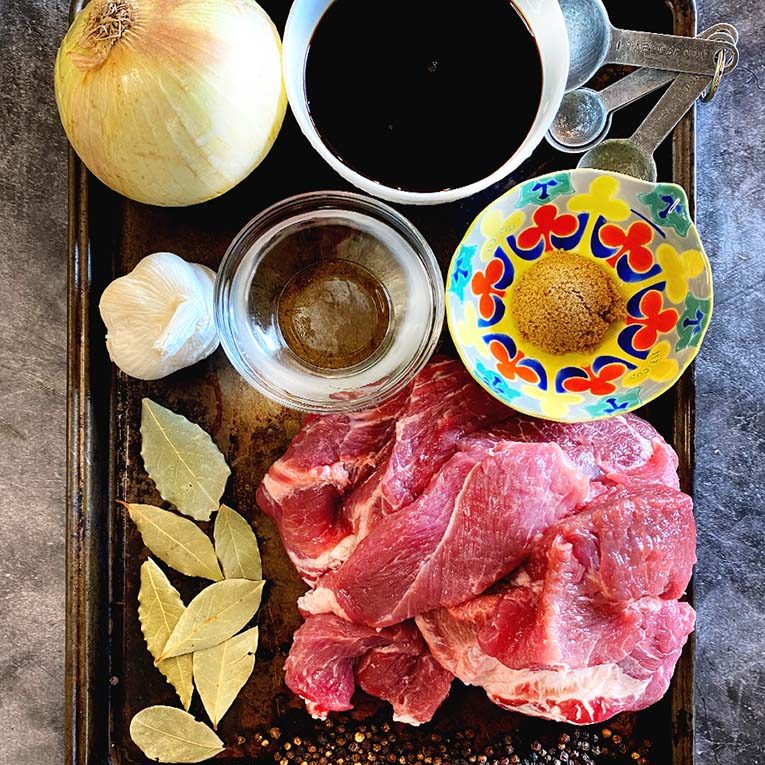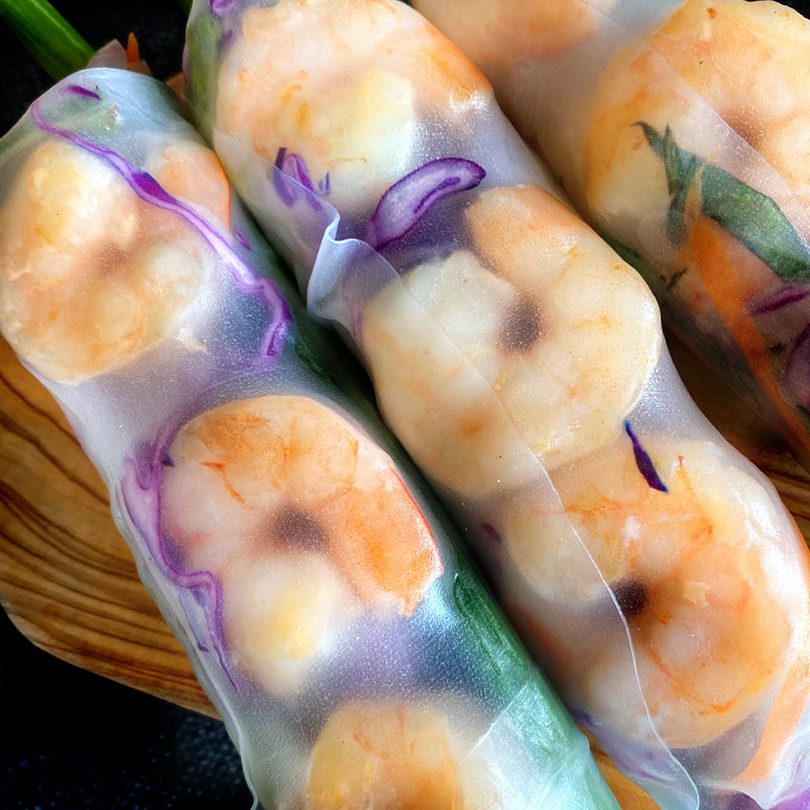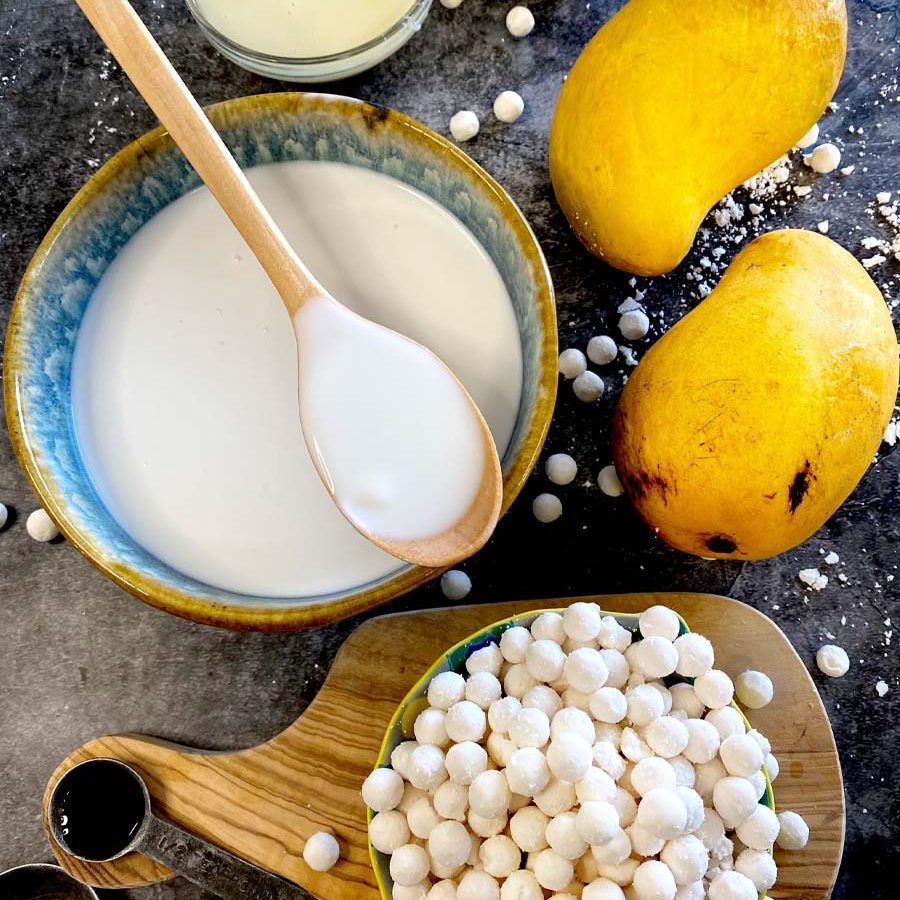Pork sinigang, also translated to sinigang na baboy, is a quintessential, delicious, Filipino soup filled with “spoon” tender pork shoulder and colorful vegetables. It particularly has the signature sour-esque flavor notes that make this creation totally addicting, satisfying, and truly comforting.

Table of contents

Growing up Filipino means sinigang is part of your life.
As a matter of fact, it’s often on the table as a staple dish that works anytime of the day, morning to night.
It was easy for mom to make, and all it required was a big spoon and side of rice.
As a kid, this was definitely one of the dishes that broadened my palate with the tasty sour-savory broth, infused with vegetables and soft meaty morsels. I could literally eat several bowls.
I actually often had sinigang with salmon heads, but for my own kids, pork or beef sinigang is my go-to dish for them. They are loving it as much as I used to.
WHATS GOOD ABOUT Natural Pork Sinigang
- This recipe has NO packets! No msg, no preservatives.
- Hearty and comforting.
- Full of vegetables and fiber.
- You can set it and forget it as you make this one-pot meal.
- You can also make a pork sinigang recipe slow cooker style by letting the pork cook longer and adding the vegetables towards the end in order of cook time.

WHAT IS Pork Sinigang
Pork sinigang is a popular Filipino soup dish, made with mouth-watering tender pork meat and an assortment of colorful vegetables.
It is known for its distinctive sour taste. A taste, however, that is super addicting and deliciously savory and vibrant.
The sour-like notes are achieved by using tamarind as the main souring agent.
You can also use tomatoes or other choices to create the tangy flavors in sinigang.
Types of Souring Agents in Sinigang
- unripe tamarind (I create an EASY tamarind paste which I recommend using.)
- tomatoes
- unripe guava
- green mangoes
- kamias (bilimbi)
These ingredients can be used individually or in combination to achieve the desired sourness in the soup.
The soup is typically made by simmering the pork to fork-tender perfection, and adding vegetables in a flavorful broth, resulting in a savory and comforting dish.
Sinigang na baboy can be enjoyed with a side of rice and is often served as a main course during meals.
It is a beloved dish in Filipino cuisine and holds a special place in the hearts of many Filipinos.

A Brief History of Pork Sinigang
Pork sinigang has a rich history that dates back to the pre-colonial period in the Philippines.
Accordingly, the dish is believed to have originated from indigenous Filipino communities who used local ingredients to create flavorful meals.
Sinigang itself traces its roots from the tamarind-based soups brought by traders from neighboring countries such as Malaysia, Indonesia, and Thailand.
The local Filipinos adapted these flavors and incorporated their own unique ingredients to create their own version of sinigang.
Despite Spanish colonialism influencing many Filipino dishes, sinigang managed to retain its indigenous roots and became a popular dish among Filipinos.
The Unofficial National Dish of the Philippines
Pork sinigang’s popularity has endured throughout the centuries and is now considered one of the “unofficial” national dishes of the Philippines.
It’s a staple dish and while can be molded to your own style, it has the distinct characteristics about it that define the nostalgia and comfort about it.
So, the history of sinigang na baboy is not only a testament to the diverse culinary heritage of the Philippines but also a reflection of the country’s ability to meld different influences into a beloved and iconic dish.

INGREDIENTS for Pork Sinigang
To make pork sinigang, you will need the following ingredients:
- pound of pork – (shoulder, belly, or any preferred cut). Shoulder is best because of the fat to lean ratio. It should have lots of marbling for best flavor.
- tamarind or 2 tablespoons of tamarind paste
- medium-sized onion – sliced
- medium-sized tomatoes – quartered
- taro (gabi) – optional
- Yardlong beans or String beans
- banana pepper – leave whole
- daikon radish – thick sliced
- long green chili peppers (or siling haba) – leave whole
- kangkong (water spinach), bok choy, or other leafy greens
- Japanese eggplant
- okra
- water
- vegetable broth
- Fish sauce (patis) or salt – to taste
- Ground black pepper – to taste
- ginger – This is optional, but I really like it with the pork.





EQUIPMENT
- 1 Dutch Oven or Stock Pot with Lid
- 1 small sauté pan
- 1 mixing ladle
- 1 skimmer
HOW TO MAKE Pork Sinigang
To make pork sinigang, follow these simple steps:
Instructions:
- Prep all your ingredients. Heat your Dutch Oven or large pot.
- Add a little oil then briefly sauté the tomatoes and onions. Add the pork shoulder and give it a quick sear on the edges.
- Pour the fish sauce all over the meat and mix well. It’s important to season the meat before adding water.
- Add the broth and water. Cover and simmer on very low for almost three hours until the pork is fork tender.
- Skim the top of the soup to remove any soup skud. The broth should be pretty clear after that. Skim the soup whenever it’s needed.
- Add the taro if you have decided to use it, and the eggplant. Also, add the daikon radish, ginger, and green chili peppers to the pot.
- Then, continue simmering for another 5 minutes until the radish becomes tender. You can also take the taro that has softened and mash it with a fork to add some thickness to the soup.
- Add the tamarind paste, beans, leafy greens, and okra.
- Taste first, then season with salt and ground black pepper as preferred. Simmer for a few more minutes until the vegetables are cooked, but still colorful.
- Remove the pot from the heat. Serve the pork sinigang with steamed rice on the side.
Tips and NOTES
- Remember to sear the pork and season it with the fish sauce or salt before adding liquid.
- Go low and slow so the pork becomes absolutely fork-tender. Give it about 3 hours at least, but do not overcook.
- Use pork shoulder or another cut with a good balance of fat to lean.
- Use a souring agent like sliced tomatoes or tamarind paste.
- DO use a skimmer to clear the broth.
- Do not overcook the vegetables.
- Eat while piping hot and fresh made.
- Don’t forget to make the rice!
ADD INS AND VARIATIONS
- Add potatoes instead of taro.
- Add Shiitake mushrooms.
- Use string beans if you can’t access Yardlong beans.
- Try beef sinigang or chicken sinigang.
- Try this recipe with shrimp or salmon heads instead of the pork.

WHAT TO SERVE WITH Pork Sinigang
Sinigang na baboy is best served with simple, steaming rice.
You can also serve sinigang with cauliflower rice, noodles, farro, or pearled barley.
Questions
Is sinigang gluten free and healthy?
Yes. This Filipino sour soup is all gluten free, contains no soy sauce, and is full of vegetables and fiber.
Can I store leftovers?
Yes, however, it is best to eat same day to keep the vegetables fresh and crisp. Leftovers last a day.
Can I freeze this?
I do not recommend unless you remove the vegetables and add fresh vegetables when reheating.
I do not have tamarind. What do I use instead?
You can use the other souring agents as in the above article. Tomatoes work perfectly for umami and “sour” elements to this sinigang soup recipe.

Natural Pork Sinigang (Sinigang na baboy)
Equipment
- 1 cutting board
- 1 chef's knife
- 1 Dutch oven or large pot
- 1 soup skimmer
- 1 ladle
Ingredients
- 1-2 lbs pork shoulder or preferred pork cut with marbling and good fat to lean ratio
- 1½ cup onion sliced chunky
- 4 tomatoes sliced chunky
- ¾ tbsp Fish sauce
- 3 cups water add a little more if needed
- 4 cups vegetable broth add a little more if needed
- 1 cup taro (gabi) remove skin and slice chunky
- 1 Japanese eggplant small size; cut chunky
- 1 tbsp ginger sliced
- 1 banana pepper keep whole
- 2 green long chili peppers siling haba, green Korean chilies, or long chilies, and keep whole
- 1 cup daikon radish 4 thick slices
- 1½ tbsp tamarind paste
- 1 cup okra
- 1½ cups Yardlong beans (sitaw) or green beans; sliced in 3" long pieces
- 1 bunch bok choy kangkong water spinach or baby bok choy works too; cut chunky
- ground black pepper to taste
- salt to taste; taste first before adding any salt.
Instructions
- Prep and lay out the ingredients. Heat your Dutch oven or large pot. Add oil.
- Sauté the tomatoes and onions for one minute. Add the pork and sear until there is a little browning.
- Add the fish sauce and mix in. Then, add the water and the vegetable broth. The pork should be submerged.
- Cover and simmer on low for almost three hours. Do not boil, be sure it is a low simmering. Use the skimmer to remove the top soup skud in order to clear up the broth.
- Add the taro, daikon radish, eggplant, ginger, and chilies.
- Once the taro is soft in ten minutes, grab some with a spoon and mash with a fork to add thickness to the soup.
- Check the pork is now tender. You should be able to cut it with a spoon. Do NOT keep cooking the meat longer than you need to, so now is the time to add the ingredients as listed below and then you are close to serving.Then, add the tamarind paste.
- Add the beans, okra, and leafy greens. Cover with a lid until the greens have wilted and are cooked. Remove the lid and give everything a good mix. Taste first, then add salt and pepper to taste. I usually do not add more salt, but it's per your preference.Serve right away and enjoy!
Notes
- Serve with rice.
- Have sides of lemon or calamansi.









Leave a Reply